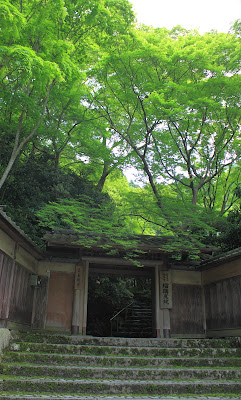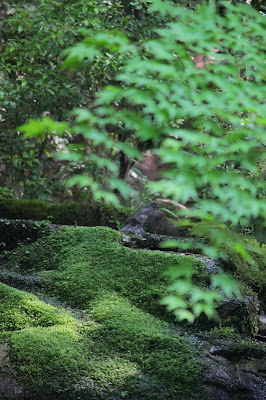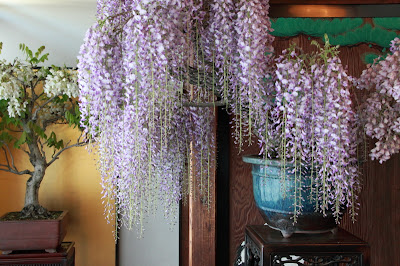Wisteria flowers are symbolic blooms in Nara. Usually, in early May no matter where you go in Nara Park, you are welcomed by the purple clusters shining in a balmy sunlight.
This year seemed not to be a good year for wisterias. Nara Park was supposed to become the paradise of wisterias. But, the clusters were shorter and the flowers were less than usual. What happened to them? Last year they did splendid jobs and pleased the eye of people. I guess the wisterias were too tired to bloom in full power and Spring Goddess decided to give them a rest.
Why are wisterias here and there in the park?
In the 8th century when Nara became the new capital of Japan, the Fujiwaras were the most powerful and rich clan. They expanded their political power through marriage with the Imperial family. The same old story here! Fujiwara means "Wisteria Field". Wisterias were the Fujiwaras' favorite flowers.
Kasuga Grand Shrine
Kasuga Grand Shrine was founded by the Fujiwaras as their family shrine as well as the guardian deity for the new capital in the 8the century. The shrine is famous for a seven hundred year old wisteria which is called "Sand-Sweeping Wisteria (砂摺りの藤)" as the clusters grow long and look as touching the ground almost. The longest cluster was measured 1.65 meters in length last year.

The Fujiwaras loved wisterias, so the hanging wisterias became the crest of the Fujiwaras as well as Kasuga Grand Shrine.
This is one of two guardian lions in front of the second Torii gate.
The crest of the Fujiwaras is carved on the pedestal.
The shrine maidens wear a crown of wisteria flowers.
This is "Rice Planting Ceremony" held every year in March in the shrine.
I have ambivalent feelings toward wisterias. The hanging flowers are graceful. The colors of wisterias, various shades of purple, are so noble. But under the flowers there are vines coiling and twining other trees. And they are climbing up and blooming on the top.
This is my blog about wild wisterias.
I love wild wisterias more than cultivated ones, because I can see the nature of the flowers in the wild wistreerias better. This year, the wild wisteria bore less and less flowers. So, no photos of them.
For me snake-like vines of wisterias look like the legacy
of the power struggles fought in the Imperial court in the 8th century.
Purple has been a noble and mysterious color since ancient times.
紫草(むらさき)の にほへる妹を 憎くあらば 人妻ゆゑに われ恋ひめやも
大海人皇子
Oh, beautiful you, like a purple grass!
How I can give up my love towards you
even though you are other man's wife!
(mentioned by Prince Oama in the 7th century)
What a passionate love letter it is! Though there is another interpretation, I'd like to take this poem as the outpouring of his emotion. According to one theory, in those days purple was so loved that the color was synonymous with purple. The flowers of purple grasses were mentioned a several times in an ancient anthology of poems which has been loved for over 1200 years by people in Japan. It is
万葉集 - Anthology of Ten Thousand Leaves.
The flowers of purple grasses are lily white. The dried roots of the grasses were used to dye clothes in deep purple and the grass symbolized a lover. I wonder what color it is. They say natural purple is much deeper than synthetic purple.
Flikering like puple stained glasses.
In
"The Tale of Genji" (
源氏物語) written by Murasaki Shikibu around the beginning of the 11th century, two ladies take important roles in the story. One is
藤壷, Lady Fuji-tsubo and another one is his wife,
紫の上, Murasaki-no-ue. Fuji means wisteria flowers and Murasaki is purple in English. Two women are depicted as his ideal female figures. Shining Genji devotes his eternal love to them. The name of the author also has the color purple.
"The Potted Wisteria Exhibition"held in May in Nara.


















































